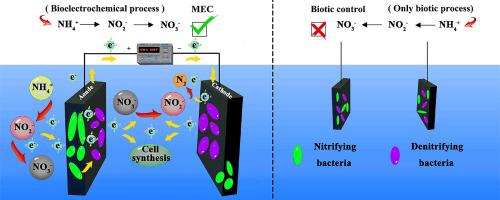Bioelectrochemistry ( IF 4.8 ) Pub Date : 2021-07-17 , DOI: 10.1016/j.bioelechem.2021.107889 Qinmao Zhou 1 , Nuan Yang 2 , Decong Zheng 1 , Lixia Zhang 3 , Chang Tian 1 , Qingzhuoma Yang 1 , Daping Li 3

|
Alternative method should be found to solve the ammonia accumulation in anaerobic digestion. Herein, electrode-dependent ammonium oxidation was successfully achieved in anaerobic single-chambered microbial electrolysis cells (MECs)under different low C/N ratios (0, 1, and 1.5), with an applied voltage of 0.6 V as well as an initial NH4+-N and NO3–-N concentration of 500 and 300 mg/L. The nitrogen removal performance of MECs and the controls indicated that applying a voltage stimulated nitrogen removal under low C/N ratios of 0, 1, and 1.5. However, the remaining organic carbon in MEC with a relatively higher C/N ratio of 3 inhibited the ammonium oxidation. Current changes and cyclic voltammetry demonstrated that the bioanode with several bioelectrochemical activities could promote ammonium oxidation. The dominant genera Truepera, Aquamicrobium, Nitrosomonas, Arenimonas, Comamonas, and Cryobacterium enriched on both electrodes could be the key functional taxa in MECs with C/N ratios of 0, 1, and 1.5. The remaining sodium acetate in MEC with C/N ratio of 3 inhibits microbial community structure and relative abundance, which may adversely affected nitrogen removal. Further caculation showed that nitrogen balance was essentially achieved, while electron balance was disrupted since electrons may be consumed through NO3−-N recycle and cell synthesis, and finally caused low coulombic efficiency.
中文翻译:

单室微生物电解池中不同低C/N比的电极依赖性氨氧化
应寻找替代方法解决厌氧消化过程中氨的积累。在此,在不同的低 C/N 比(0、1 和 1.5)下,在 0.6 V 的施加电压和初始 NH4 条件下,在厌氧单室微生物电解池 (MEC) 中成功实现了电极依赖性氨氧化。4 + -N 和 NO 3 –-N 浓度为 500 和 300 mg/L。MEC 和对照的脱氮性能表明,在 0、1 和 1.5 的低 C/N 比下,施加电压可促进脱氮。然而,MEC中剩余的有机碳具有相对较高的C/N比为3,抑制了铵的氧化。电流变化和循环伏安法表明具有多种生物电化学活性的生物阳极可以促进铵的氧化。优势属Truepera、Aquamicrobium、Nitrosomonas、Arenimonas、Comamonas和Cryobacterium在两个电极上富集的 MEC 可能是 C/N 比为 0、1 和 1.5 的关键功能分类群。C/N比为3的MEC中剩余的乙酸钠会抑制微生物群落结构和相对丰度,这可能会对氮去除产生不利影响。进一步计算表明,氮平衡基本达到,而电子平衡被破坏,因为电子可能通过NO 3 - -N循环和细胞合成被消耗,最终导致库仑效率低。









































 京公网安备 11010802027423号
京公网安备 11010802027423号